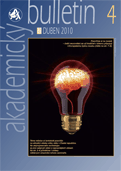The Prehistory of Bohemia in 7 volumes has been released

1 Sep 2014
Archaeological find of a church at Vyšehrad

20 Aug 2014
In July 2014, research of the Institute of Archaeology in Prague continued in the areas of the Basilica of St Lawrence at Vyšehrad. The research that has provided very interesting information in the area of early medieval sacral architecture was financially supported by the Magistrate of the Capital City of Prague, the royal collegiate chapter at Vyšehrad, Institute of Archaeology of the ASCR in Prague, v. v. i., and the Prague Archaeological Fund. The systematic research of the Institute of Archaeology in Prague, which has been devoted to Vyšehrad in Prague for several decades now, continued this year.
Connecting the worlds of semiconductors and magnets

20 Aug 2014
Researchers from the Institute of Physics ASCR realize an efficient spin-charge converter
Current information technologies are either charge-based or spin-based. Semiconductor microprocessors are prime examples among the large variety of charge-based devices. They utilize the possibility offered by semiconductors to easily electrically manipulate and detect their electronic charge states representing the zeros and ones. Spin-based devices operate on an entirely distinct principle.
Genetic blueprint of bread wheat genome unveiled

17 Jul 2014
Institute of Rock Mechanics and Structure ASCR has become a Worldwide Centre of Excellence

14 Jul 2014
The scientific teams of the Academy of Sciences of the CR and Charles University have received significant awards for their results so far in long-term joint research of landslides. The Institute of Rock Mechanics and Structure (ÚSMH) of the ASCR, v. v. i, along with the Faculty of Science of CU obtained the title of a Worldwide Centre of Excellence for Research of the Risks of Landslides in Beijing in June of this year.
The zebrafish as an aide in modern haematology

11 Jul 2014
A current trend of modern biomedical research is the attempt to minimalize experiments on animals like mice or chickens and where it is possible to replace them with developmentally simpler model organisms, but it is a necessary precondition that some basic cellular and physiological processes are evolutionarily conserved with these organisms, by which the similarity with the processes taking place in more complex organisms is preserved. One such biological model is the aquarium fish, the zebrafish, named for its zebra-like stripes.
Ultraviolet light enables to find white-nose syndrome in bats

4 Jun 2014
The Protest Movements in the Contemporary Middle East

2 Jun 2014
Prof. Noam Chomsky appeared at the Academy of Sciences of the CR

2 Jun 2014
One of the most important scientists of today, Professor Avram Noam Chomsky from Massachusetts Institute of Technology appeared on Monday, 2 June 2014 at the headquarters of the Academy of Sciences of the CR with a lecture “What Can We Understand?” On this occasion, he received from the hands of the President of the ASCR Prof. Jiří Drahoš the honorary medal “De scientia et humanitate optime meritis”. Over the next few days, Prof. Chomsky will attend a linguistics conference organized by the Faculty of Arts of Palacký University in Olomouc and a public debate on current social trends in the Metropol Cinema in Olomouc.
Quantifying the impacts of alien species: towards an IUCN Black List

12 May 2014
One of the major transformations of the planet from human activities is the wholesale redistribution of species, through the deliberate or accidental translocation of their populations to areas outside their native range. These “alien” species have in many cases caused substantial deleterious impacts to the recipient environment (e.g. extinctions of native populations and species, the disruption of soil nutrient and water cycling, and natural disturbance regimes). Preventing and mitigating such impacts is a major drain on limited conservation resources.






Because Katareeya originates from a “third country”, namely, Australia, according to the Czech legislation she is not entitled to healthcare support from the public healthcare insurance.
More information...